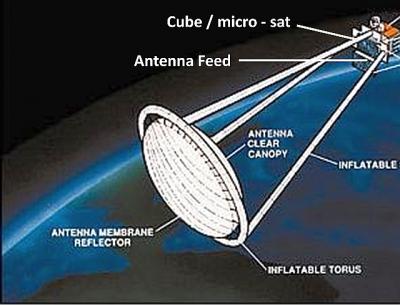MSc thesis project proposal
Design of an inflatable antenna for nano- and micro-satellites
Project outside the university
Dutch Space, an EADS Astrium companyThe optimization of the antenna performance is a key issue in the design of satellite systems. Even if the current trends are toward miniaturization of all equipment and platforms, antenna size is expected to grow for higher sensitivity instruments and access to the end user with small terminal. The major bottleneck is that the desired size for the antenna is larger than the available stowage volume. A promising solution which was developed a few decades ago is the inflatable parabolic antenna. The development of this inflatable concept stagnated however because the required surface tolerance of the parabolic dish could not be attained.
Most of these error sources can however be significantly reduced due to recent developments that are made concerning new materials and manufacturing processes. New inflatables can be made with materials that have a near-zero-thermal-expansion-coefficient and a variable stiffness such that the deformations in the membrane are everywhere the same in every direction. This means that the inflatable is less sensitive for thermal distortions and that shape of the parabolic membrane is always a parabola, only the size is different and consequently a function of the pressure.
The goal of this project is to do the system design of inflatable antennae for nano- (range 1-10kg) or micro-satellites (range 10-100kg). The goals for these spacecraft become more ambitious in terms of physical distance (moving from Low Earth Orbit (LEO) to Geostationary Earth Orbit (GEO) or further), and of the amount of data to relay back to Earth (from Kbits to Mbits). The communication systems currently implemented (mostly dipole, monopole or patch antennae) are not able to fully support those missions. Furthermore, a small variant of the inflatable concept enables the technology development for larger versions while reducing the risks and investment costs considerably.
Assignment
The list underneath provides an overview of the research questions that will to be solved in this project:
-
Make a trade-off between a) the inflatable parabolic reflector antenna, b) the inflatable phased array antenna and c) the inflatable reflect array antenna. This trade-off covers the increase in costs and power consumption due to accurate pointing of the parabolic reflector vs. costs and extra power required for transmitting data using array antennae. The results of the trade-off will determine which mission is best suited for each inflatable concept.
-
Provide input for the inflatable design:
-
shape (�, focal length)
-
architecture w.r.t. S/C
-
Feed Design and determination of RF-performance figures
Contact
prof.dr. Alexander Yarovoy
Microwave Sensing, Signals and Systems Group
Department of Microelectronics
Last modified: 2020-09-23
